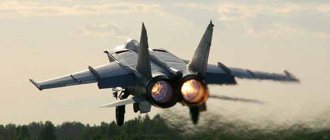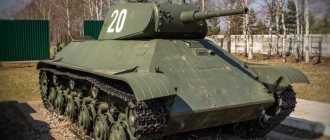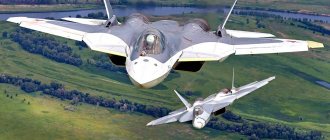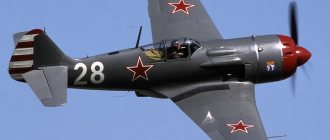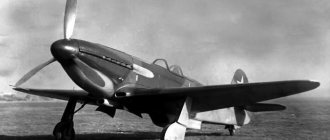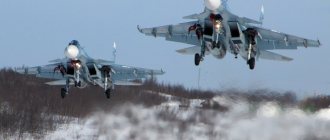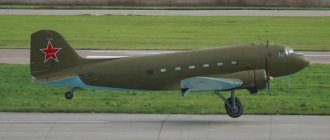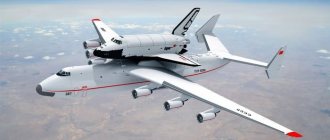The aircraft continues the line of combat aircraft of the Su-30MKI family, created on the basis of the Su-30 aircraft for India.
The Su-30SM is super maneuverable, equipped with a phased array radar, thrust vectoring engines and a front horizontal tail surface. Can be used to train pilots for advanced multifunctional super-maneuverable single-seat fighters.
The fighter is adapted to the requirements of the Russian Air Force in terms of radar systems, radio communications and state identification, weapons, an ejection seat and a number of support systems.
The Su-30SM fighter is capable of operating day and night, in any weather conditions; it can not only shoot down enemy aircraft and destroy ground targets, but also conduct aerial reconnaissance and provide target designation to other aircraft of the group (including Su-34 bombers).
The aircraft has a long flight range and the ability to refuel in the air.
The Su-30SM design does not use stealth technology, so its defense is based on suppressing enemy radar stations using a powerful on-board electronic warfare system.
A high degree of maneuverability of the aircraft is achieved due to the front horizontal empennage (FH) and engines with thrust vector control. In general, the dimensions and layout of the fuselage are completely identical to the Su-30 and Su-30MKI fighters. The pilots are seated in tandem in the cockpit.
The aircraft is equipped with a Bars on-board radar control station, which is capable of targeting 15 objects and hitting one short-range target or four long-range ones, as well as overcoming interference from enemy electronic warfare systems. The Su-30SM uses a helmet-mounted target designation system, as well as a heads-up display. In addition, the cockpits are equipped with multifunctional LCD screens. All this provides pilots with the highest level of air situation awareness.
Close combat is made possible by the optical-location station built into the cockpit; it is a subsystem of the weapons control system. Based on the principle of detecting and tracking a target using thermal radiation, the target range is measured by a laser range finder, and the data is displayed on the screen. The same system monitors the proper operation of all components, the strength of the structure and the flight condition of the aircraft.
The Su-30SM can be equipped with suspended containers with laser and infrared sighting equipment. The fighter is equipped with an inertial navigation system with a satellite signal receiver from the GLONASS system, this ensures high accuracy of following the route. The Su-30SM can fly automatically in different modes, including low-altitude flight, landing approach, and also during attacks against ground and surface targets. The system providing automatic control is connected to the navigation system.
The combat load of the Su-30SM fighter is eight thousand kilograms. The aircraft has twelve hardpoints, which can accommodate a wide range of missile and bomb weapons. These could be six guided missiles for air combat at medium or short distances, unguided bombs weighing 500 or 250 kilograms, containers with unguided aircraft missiles. In addition to missile and bomb armament, the aircraft is equipped with a 30-mm GSh-30-1 cannon.
Su-30 fighter-bomber - features and capabilities
multirole fighter-bomber is a further development of the Su-27UB combat training fighter. It was first shown to the public as a modification of the Su-30MK (export “Multipurpose Commercial”) in 1993 at the Dubai Air Show.
The Su-30 is truly a multi-role aircraft - both a fighter and a bomber; it copes no less successfully with the tasks of a long-range fighter-interceptor, and with a set of additional equipment, it can be used as an air command post. As a “command” aircraft, using onboard pulse-Doppler radar it can simultaneously target up to 4 Su-27 interceptors (the duties of the aircraft commander in this case are performed by the co-pilot).
In addition to its main tasks, depending on the set of weapons, the Su-30 can be used as a fighter-attack aircraft, a fighter-bomber and an air superiority fighter. In short, the “jack of all trades” Su-30 can perform the tasks of “specialists” such as the Su-17, Su-24 and Su-27, and due to its better characteristics, it copes with them 2-2.5 times more efficiently .
Drawing of the Su-30 multi-role fighter-bomber
If we add to this the fact that the Su-30MKI modification is equipped with engines with rotary nozzles, providing the aircraft with the so-called. “super maneuverability”, then the Su-30 can rightfully be called one of the best universal aircraft in the world.
In terms of the totality of their combat qualities, the latest Su-30 fighters are practically in no way inferior to fifth-generation fighters, except perhaps the requirements for stealth. However, the lack of “stealth” technologies in the design of the Su-30 is not an annoying misunderstanding, but an inevitable consequence of the role performed by the aircraft. Having the most powerful means for radar reconnaissance and acting as a coordinator and gunner for a flight of fighters, the Su-30, even from a logical point of view, cannot be “inconspicuous”.
Su-30SM fighter-bomber
Su-30 fighter-bomber - design
Structurally, the Su-30 is generally similar to the Su-27UB. Composite materials and high-strength aluminum and titanium alloys are widely used in the aircraft design.
The pilot's cabin is sealed and equipped with two ejection seats. The power plant consists of two turbojet engines. At takeoff, their thrust reaches 12,500 kgf. The maximum fuel reserve in the internal compartments is 10 tons, which provides a range of 3000 km without air refueling. The aircraft is equipped with an in-flight refueling system; drop tanks are not provided.
Su-30 fighter-bomber
Features of the Su-30: integral aerodynamic layout, fly-by-wire control system, automatically deflecting mechanization of the leading and trailing edges of the wing, a new flight and navigation system and a set of on-board weapons.
The Su-30 fighter-bomber is equipped with a 30-mm GSh-301 cannon, traditional for many Sukhoi Design Bureau aircraft, with 150 rounds of ammunition, but the missile weapons have been significantly improved. The aircraft's strike armament includes S-29L, Kh-29L and Kh-25ML missiles with a laser target guidance system, as well as a Kh-29T missile with a television guidance system, which operates on the “fire and forget” principle. The Kh-59M missile transmits to the cockpit screen the image broadcast by its homing head. Following radio commands from the pilot, it hits the target with a direct hit. The Kh-31P missile is designed to combat enemy radars.
Additional armament capabilities of the Su-30 fighter-bomber include 500 kg bombs, unguided rocket launchers and external cannon mounts.
If the aircraft is used as a fighter-interceptor, it can be armed with air-to-air missiles with radar and thermal imaging heads.
Diagram of the Su-30 multi-role fighter-bomber
B PYULYUU TSNYANNPNMGYUYUGYU. ONYAKE HYAOSHRYUMKHI MU GELKE H B BNGDSUE YAYULNKERSH BSHKEREKH HG YNLANLNKEYAYU-MU-YULSPE Y LEYARS ONYARNMMNI DHYAKNYUZHHH. yPNLE RNTSN, B lKHMNANPNMSH YANNAYHKKH, VRN DN YNMZHYU 2014 TsNDYU bbya ONKSVYUR EYE MEYAYNKEIN KHYARPEAHREKEY YAS-30l2. YNKHVEYARBN YYULNKERNB ME PYUGTSKUYUERYA. b 2010 TsNDS GYUBEPYEMSH GYUBNDYAYKHE K╦RMSHE HYAOSHRYUMKH OEPBNTSN YAEPKHIMNTSN YaS-30l2.
lMNTSNZHEKEBNI KHYARPEAHREKE YAS-30l2 ASHK YANGDYUM AYUGE KHYARPEAHREK YAS-30 (BEPIAH YAS-30Ly2, OPEDMYUGMYUVEMMYU DK bbya pNYYAHH). nM OPEDMYUGMYUVEM DK SMKHVRNFEMKH OKHKNRKHPSELSHU X AEYAOKHKNRMSHU KERYUREKEMSHU YOOYUPYURNB SOPYUBKELSHLH PUYERYULH YAPEDMEI DUKEMNYARH X AKKHFMETSN BNGDSMNTSN AN. yPNLE RNCN, YaS-30l2 LNFER ONPUFYURE MYUDBNDMSHE KH MUGELMSHE ZHEKH BIAELKH BHDYULKH BNNPSFEMKH B KCHASHU LERENSYAKNBKHU. YaYULNKER LNFER HYAONKEGNBUREYA DK NASVEMKH KERMNTSN YANYARYUBYU REUMKHYE OHKNRKHPNBUMHYE X OPHLEMEMHYUBKHYUZHNMMMSHU YAPEDYARB ONPUFEMEKH. nR AYUGNBNI BEPIAHKH YAS-30L2 NRKHVYUERYA SBEKHVEMMNI DUKEMNYARECH ONKERYU, YU RUYFE ANKEE YANBEPEMMSHL ANPRNBSHL NANPSDNBYUMHEL.
NYAMNBMSHHLH NYNAEMMNNYARLH YAYULNKERYU YAS-30L2 ЪБКЪЧРЯ LNDХТХХПНБУММУЪ YAKHYARELYU SOPYUBKEMH BNNPSFEMKHEL I PUYAHPEMMSHLH BNGLNFMNYARILH ON ONPYUFEMKHCH MUGEL MSHU X LNPYAYKHU ZHEKEY; MNBYU YAKHYARELYU KHMDHYUZHHH B YYUAHME SHYHOYUFYU MU NYAMNBE ZBERMSHU LMNTsNTSMYZHNMYUKEMSHU FHDYNYPHYARYUKKHVEYAYKHU KHMDHYURNPNB; SKSVIEMMYU YAHYARELYU MYUBHTSYUZHHH PUDHNYABGHH; YANBPELEMMYU YOOYUPYURSPYU ANPRNBNTSN YNLOKEYAYU NANPNMSH; LKHPNYYU MNLEMYKURSPYU BNNPSFEMKH YKYUYAYANB "BNGDSU-BNGDSU" X "BNGDSU-ONBEPUMNYARE", PYUGLEYUELNTSN MU 12-RKH RNVYUU ONDBEYAYKH; YAHYARELYU DNGYUOPYUBYKH RNOXBNL B ONKERE; SYAKHKEMMYU YNMYARPSYZHKH OKYUMEPYU X YUYAYAH, NAEEAOEVKHBUCHYYU SHYYAOXYURYUZHCH YYULNKERYU I ONKMNI GYUOPYUBYNI RNOXBNL X LYYYAHLYUKEMNI ANEBNI MYUTSPSGYNI OPH BGKERMNI LYUYAYE DN 38 RNMM.
YAKHYARELYU SOPYUBKEMKH BNNPSFEMHEL YAYULNKERYU YAS-30L2 NAEYAOEVKHBUER NAMYUPSFEMKHE, YANOPNBNFDEMKHE X SMKHVRNFEMKHE YUBKHYUZHNMMSHLKH YAPEDYARBYULH ONPUFEMKH BNGDSMSHU, MYUGELMSHU X L NPIAYKHU JACKEYS B KCHASHU ONTSNDMSHU SYAKNBHYU DMEL X MNVECH.
nMYU BYKCHVIUER B YAEAJ DBE NYAMNBMSHE YAHYARELSH:
- SKHYARELS SOPYUBKEMKH BNNPSFEMHEL YKYUYAYU "BNGDSU-BNGDSU", YANYARNYYSCH KH PUDHNKNYUZHHNMMNTSN OPKHZHEKEMNTSN YNLOKEYYAYU, NORKHYN-SHKEYRPNMMNI OPKHZHEKEMNI YAKHYARELSH YAHYARE LSH KHMDHYUZHHH MU TNME KNANBNTSN YAREIKYU.
- SKHYARELS SOPYUBKEMKH BNNPSFEMHEL YKYUYAYU "BNGDSU-ONBEPUMNYARE", NAEYAOEVKHBUCHYSCH OPHLEMEMKHE UBNYNI MNLEMYKURSPSH BSHYANINRNVMNTSN NPSFKH DK ONPYUFEMKH MUGELMSHU ZHEK EI, YU RUYFE NRNAPYUFEMHE BYAYE OPHZHEKEMN-MYUBKHTSYUZHNMMNI HMTNPLYUZHHH MU 4-U LMNTSNTSMYZHNMYUKEMSHU KHMDHYURNPYUU, PUYAONKYUTSYUCHYCHYKHYUYU OPKHANPMSHU DAYYUU YUAKHMSH SHYHOYUFYU.
NYAMNBS KHMTNPLYUZHNMMN-SOPIUBKYETSN ONK YYUAKHMSH YAYULNKERYU YANYARYUBKCHR ZBERMSHE LMNTsNTSMYZHNMYUKEMSHE KHMDHYURNPSH LTH-55, KHMDHYURNP MU TNME KNANBNTSN YAREIKYU (B OEPBNI YUAHME), MU YNRNPSHE B TSPIUTKHVEYAYNI KH ZHHTPNBNI TNPLE BSHBNDHRYA BEYAE MENAUNDHLSHI NAZEL OPKHZHEKEMN-OHKNRYUFMNI KH MYUBKHTSYUZHNMMNI KHMTNPLYUZHKH, YU RUYFE KHMTNPLYUZHKH N PU ANRE ANPRNBSHU YAHYAREL YYULNKERYU. mYUPЪDS I LTH MU OPKHANPMSHU DAYYU YUAHMSH PYUGLEYUCHRYA KH RPYUDHZHNMMSHE SHCHKEIRPNLEYUMHVEYAYHE KHMDHYURNPSH, YNRNPSHL NRBNDYURNPSH B NYAMNBMNL DSAKHPSCHYKHE TSMY JXX.
MU YAS-30l2 YARNHR apkya m001b, ЪБКЪЧыУЪЯЯ LNDEPMHGYUZHHEI apkya, SYARYUMNBKEMNI MU YAS-27. pYUDKHNKNYUZHHNMMMYU YARYUMZHH (pkya) YAYULNKERYU B PEFHLE “BNGDSU-BNGDSU” NAEYAOEVKHBUER: ONKHYAY BNGDSMSHU ZHEKEY; NONGMYUBYUMKHE TSNYASDYUPYARBEMMNI OPKHMYUDKEFMNYARKH NAMYUPSFEMMSHU ZHEKEY; YURYUYS ZHEKEY PUYERUL X LUKNI X YAPEDMEI DUKEMNYARKH I PUGKHVMSHLH YAHYARELYULH MYUBEDEMH; ONKHYAY, GUUBYUR X YANOPNBNFDEMKHE BHGSYUKEMN BHDHLNI ZHEKH B AKKHFMEL LYUMEBPEMMNL ANCH; B PEFHLE “BNGDSU-ONBEPUMNYARE”: BYAEONTsNDMNE NAMYUPSFEMKHE, KHGLEPEMKHE YNNPDHMYUR PUDHNYNMRPYYARMSHU MYUGELMSHU H MYUDBNDMSHU ZHEKEY; BSDHYUVS YNNPDHMYUR MUGELMSHU (MYUDBNDMSHU) JACKEYS DK NAYEOEVEMH OPHLEMEMH PUYER u-31yu, u-35sch, u-59ly.
NORKHYN-SCHKEIRPNMMYU OPKHZHEKEMYU YAKHYARELYU BYKCHVUER B YAEAJ NORKHYN-KNYUZHNMMSCH YARYUMZHCHCH X MYUKELMSCH YAKHYARELS ZHEKESYUGYUMKH. NORKHYN-KNYUZHNMMYU YARYUMZHH YYULNKERYU YAS-30L2, OPEDYARYUBKCHYYU YANANI YNLAKHMYUZHCH NAGNPMN-YAKEDYETSN REOKNOEKEMTSURNPYU KH KYUGEPMNTSN DUKEMNLEPYU-ZHEKESYUGYUREK , HYAONKEGSERYA DK NAMYUPSFEMH X YANOPNBNFDEMH BNGDSSMNI ZHEKKH B OEPEDMEI X GYUDMEI EE ONKSYATEPUU HE REOKNBNLS GHKSVEMKHCH, KHLPEEMKH DUKEMNYARKH KYUGEPMSHL KSVNL DN B NGDSSMNI X MUGELMNI ZHEKH, YU RUYFE LNFER OPHLEMREYA DK KYUGEPMNTSN ONDYABERYU MUGELMNI ZHEKKH OPH OPHLEMEMHH SOPYUBKELSHU PUYER YKYUYAYU "BNGDSU-ONBEPUMNYARE" I ONKSUYRKHBMNI KYUGEPMNI TSNKNBYNI YA YULNMYUBEDEMKH.
oEPBSHL XG YAEPHKH MNBEIHKH YYULNKERNB YAS-30L2, YAS-30YAL X YAS-35 bbya pNYAYAHH ONKSVHKH HYARPEAHREKE YS-30L2. ETSN TNRNTsPYUTHKH MU YUBKHYUAYUGE "yPSHLAY", PUYAONKNFEMNI B CHFMNI VYUYARKH yPYUYAMNDYUPAYNTSN YPYU, ASHKH NOSAKHYNBYUMSH B DEYUAPE 2011 TsNDYU. b MNYAPE 2013-CN MU YUBHYUAYUGS “dNLMYU” OEPEAPNYEMSH RPH YAYULNKERY YAS-30YAL. y YNMZHS OPNKNTSN TSNDYU MU ShchRS YUBHYUAYUGS ONYARYUBKEMN B NAYYEI YAKNFMNYARKH DEYARE YYULNKERNB. OEPEDYUVYU EYYYARKH LYUHM NFKHDUERYA B SCHRNL TsNDS, B PEGSKERYURE VETSN ONKMNYARECH GYUBEPKHRYA TNPPLKHPNBYUMKHE YUBKHYUZHNMMNTSN ONKYU. b TEBPYUKE 2014-CN OEPBSHE KHYARPEAHREKH YAS-35ya ASHKKH OEPEDIUMSH 23-LS KHYARPEAHREKEMNLS YUBKHYUZHNMMNLS ONKYS, AYUGHPSCHYELSYA MU YUBKHYUAYUGE "dGELTSKH" B UYUAYUPNBYA YNL YPYUE. ON LMEMKHCH YAOEZHHYUKHYARNB, HYARPEAHREKE YAS-30L2, OEPBSHL BYARSOKHBKHI B YARPNI bbya pNYAYAHH, — MYUHLEMEE YANBEPEEMMSHI HG BYAU RPEU YAYULNKERNB. nM ЪБКЪРЯЪ ПУГБХРХЛ ЛНДОКХ ЯС-30лйй, ПУГПУАНРИУМНИ йМууг ДКЪ йХРУЪ.
YAMNBMNI BMEMEI NRKHVKHREKEMNI VEPRNI YAS-30L2 PNYAYAHH ЪBKЪCHRYA DBYU UBNYARNBSHU YHK I OKNYAYNI BEPUMEI YPNLINEY. oEPBSHI GYUYUG MU OPNHGBNDYARBN YAS-30l2 DK PNYYAKHIYAYKHU bbya ASHK ONKSVEM KERNL 2009 TsNDYU. schRKH YAYULNKERSH HLECHR LMNTSN NAYETSN I NDMNLEYARMSHL HYARPEAHREKEL I SKSVIEMNI YUBKHNMKHYNI YAS-27YAL3, YNRNPSHY RUYFE OPNKHGBNDHR yMyuyug, KH I YAYULNKERYULH YAS-27 OEPBNTSN ONYNKEMKH Kommersant lHMKHYAREPYARBN NANPNMSH GYUYUGYUKN VERSHPE HYARPEAHREK YAS-30l2 X DBEMUJURE YAS-27l3. YaOJHYUKHYARSH OPEDONKYUCHR, VRN DBSULEYARMSHE YYULNKERSH ASDSR ONDDEPFHBYURE NDMNLEYARMSHE B UNDE BSHONKMEMKH SVEAMN-ANEBSHU GYUDYUV H, BNGLNFMN, B YUVEYARBE BYAYEONTSNDMSHU KHYARPE AHREKEY. MU DYUMMSHI LNLEMR NAYKHI NAZEL GYYUGNB MU HYARPEAHREKH YAS-30l2 YANYARYUBKER NYNKN 20 LYUHM. mu DEYUAPE 2013-CN ASHKN ONYARYUBKEMN VERSHPE YAYULNKERYU. YaS-30Yal, BMEME DNYURRNVMN YAHKEMN MUONLKHMYUCHYKHI YAS-30L2, OPNKHGBNDHRYA YNMYSPEMRNL yMyuyug - YNPONPYUZHHEI "xPYSR".
YaS-30l2, BNGLNFMNYARKH YNRNPNTSN MYUKHLEMEKHE HG BYAYEI RPNIIKH YAYULNKERNB, HLEER, ON LMEMKHCH YAOEZHKHYUKHYARNB, MEGMYUVKHREKEMSHI LNDEPMHGYUZHNMMSHHI ONREMZHKHYUK.
cru:
| lNDHTHYUZHH | yaS-30l2 |
| pYUGLUU YPSHKYU, L | 14.70 |
| dKKHMYU YAYULNKERYU, L | 21.90 |
| bSHYANRYU YAYULNKERYU, L | 6.40 |
| OKNYYUDE YPSHKYU, L2 | 62.00 |
| I love it | |
| MNPLYUKEMYU BGKERMYU | 24900 |
| LYUYAHLYUKEMYU BGKERMYU | 34500 |
| I love RNOXBY, JC | |
| MNPLYUKEMYU | 5270 |
| LYUYAHLYUKEMYU | 9720 |
| dBHTSUREKH | 2 rpddt yuk-31t |
| rtsyu, ytsya | 2 U 12500 |
| LYUYAKHLYUKEMYU YAYNPNYARE, YL/V | |
| MU BSHIANRE | 2100 (l=2.0) |
| WITH GELKH | 1400 |
| oPUYRHVEYAYU DUKEMNYARE, YL | |
| AEG DNGYUOPYUBYKH | 3000 |
| I NDMNI DNGYUOPYUBYNI B BNGDSUE | 5600 |
| oPUYIRKHVEYAYKHI ONRNNKNY, L | 17300 |
| lyuYa. SHYYAOXYURYUZHNMMMYU OEPETSPSGYU | 9 |
| schYHOYUF | 2 |
| bNNPSPHEMHE: | 30-LL OSYa ts-301 I ANEGYUOYUYANL 150 BSHYARPEKNB, SYARYUMNBKEMNI YAOPYUBYU B MYOOKSHBE YPSHKYU. mu 12 OKHKNMNB ONDBEKHBUERYA 8000 YTS ANEBNI MYUTSPSGYKH (OPH ShchRNL YUFDSHI NRDEKEMSHI OKHKNM LNFER APYURE DN 1500 YTS.) b E╦ YANYARYUB BUNDIR: DN 6 sp YKYUYAYU ⌠BNGDSU-BNGDSU■ RKhonB p-27p/schp/, p-73sch X p- 77 (pbb-yue) HKKH 2 p-27o (scho), p-27r1 (schr1) DN 6 sp YKYUYAYU ⌠BNGDSU-ONBEPUMNYARE■ RHONB u-29r/k, u-25lk, u-25kd, u-31yu/o X i-25k; HKH 2 joint venture u-59lsch 6 YUBKHYUANLA yua-500yp, yua-500nd HKH 3 yua-1500yp, yua-1500k YABNANDMNOYUDYUCHIKHE YUBHYUANLASH YUKHAPNB NR 100 DN 500 YC; 8 ANLANBSHU YUYAYAER pai-500 Soashch-d; DN 8 GUFKHTSUREKEMSHU AYUNB ha-500 or mspya i-8, i-13 X i-25. oPEDSYALNRPEMYU RUYFE ONDBEYAYU YNMREIMEPNB I YOOOOYUPYURSPNI pscho, KYUGEPMSHLH DUKEMNLEPMN -ZHEKESYUGYUREKEMSHLH YAHYARELYULH, hy-YARYUMZHKHLH. |
| bottom. KhMTNPLYUZHKH: |
| tNRNCPYUTHH: | YaS-30l2 (c) Ilya the Nightingale |
| YaS-30l2 (c) LYUYAHL aPMYAYKHI | |
| YaS-30l2 (c) UPREL YARUPYNB | |
| YaS-30l2 (c) Cheburashka | |
| YaS-30L2 (c) merlion86 | |
| oEPEDM YYUAHMY YAS-30L2 (c) Twower | |
| gYUDMЪ YUAHMYU YAS-30l2 (c) Twower |
| YaOHYANY HYARNVMKHYNB: |
| yMyuyuon. dBSULEYARMSHI LMNTsNZHEKEBNI KHYARPEAHREKE YS-30L2 Bmpd. MNBSHE HYARPEAHREKH YAS-30l2 Russianplanes.net. YaSUNI YaS-30l2 |
sTSNKNY MEAYU. 2018
Modifications of the Su-30 fighter-bomber
- Su-30 (1992, NATO designation: Flanker-C) is the basic model of a two-seat multirole fighter-bomber created on the basis of the Su-27UB combat trainer fighter.
- Su-30K
(K - Commercial, 1993) - a commercial version of the Su-30 with an in-flight refueling system and satellite navigation. - Su-30MK
(MK - modernized, commercial, 1993) - Su-30 with an expanded range of weapons, increased combat load from 4 to 8 tons, increased airframe life by 1/3 (up to 3000 hours) and almost doubled engine life (1500 hours). Take-off weight increased from 30 to 38.8 tons. - Su-30MKI
(modernized, commercial, Indian, 1997, NATO designation: Flanker-H) - Su-30MK for India, featured a front horizontal tail, a thrust-vectoring engine, a new N011M radar with a passive phased array antenna (PFAR) and an expanded range of air-to-air and air-to-surface weapons.
The armament of one of the Indian Su-30s.
- Su-30KN
(commercial, new, 1999) is a heavy fighter based on the Su-30K with a modernized avionics and radar with an additional autonomous radar channel with Pero phased array. Television screens for line-of-sight indicators in the cockpits have been replaced with liquid crystal color displays. An MVK computer has been added to the weapon control system to control the new air-to-air and air-to-ground missiles R-77, Kh-31, Kh-59, Kh-29. - Su-30MKK
(modernized, commercial, Chinese, 1999, NATO designation: Flanker-G) - Su-30MK for China? has expanded capabilities for working against ground targets. Radar N001VE, engines - AL-31F. - Su-30MKI(A)
(modernized, commercial, Indian for Algeria) - Su-30MKI for Algeria, featured N011M radar. - Su-30MKM
(modernized, commercial, Malaysian) - Su-30MKI for Malaysia, distinguished by N011M radar. - Su-30MK2
(modernized, commercial-2, 2002) - an improved Su-30MK with AL-31F engines and N001 radar. - Su-30MK2V
(modernized, commercial, Vietnamese) - Su-30MK2 for Vietnam.
- Su-30MK2V
- Su-30MK2 for Venezuela. - Su-30M2
(2010) - Su-30MK2 for the Russian Air Force. - Su-30SM
(serial modernized, 2012) - Su-30MKI with AL-31FP engines for the Russian Air Force.
TARGET EQUIPMENT.
The Su-30 aircraft can be equipped with a system for controlling the actions of a group of interceptor fighters. The Su-30MK fighter will be equipped with a phased array radar. The on-board information complex also includes an optical-electronic location system, including a heat direction finder and a laser range finder. There is instrument guidance equipment along a noise-protected line, which carries out the aircraft's launch to the target in director mode according to commands from the ground control unit. Navigation equipment includes satellite navigation equipment that allows you to work with GLONASS (Russia) and Navstar (USA) systems. In this case, the aircraft’s on-board equipment automatically switches to the system that currently provides the highest accuracy. There is the possibility of automatic low-altitude flight in terrain following mode. Each cabin is equipped with multifunctional color indicators on liquid crystals with a push-button frame. The displays display 2D and 3D images of the area from a digital database. The upgraded HUD displays additional information to support the attack of ground targets. In the future, it is planned to implement an object recognition mode and overlay radar and optolocation images on a digital map of the area. The selection of information to be presented to the pilot is carried out automatically, in accordance with the flight mission (a special scenario for presenting information has been created). The use of high-performance processors in combination with new software made it possible to introduce elements of artificial intelligence in the form of “tips” to the crew of the best options for action in a specific combat situation.
Characteristics of the Su-30
A country:RussiaType:Multirole fighter-bomberYear of issue:1992Crew:2 peopleEngine:2 DTRD AL-31-F2 each 12500 kgfMaximum speed:2500 km/hPractical ceiling:18 kmRange of flight:3000 kmEmpty weight:No informationMaximum take-off weight:34 tWingspan:14.7 mLength:21.9 mHeight:5.9 mWing area:No informationWeapons:Gun GSh-30-1, variable: air-to-air missiles, NURS, bombs, etc.
Source: compilation based on publicly available information on the Internet
